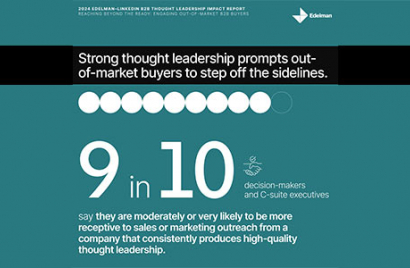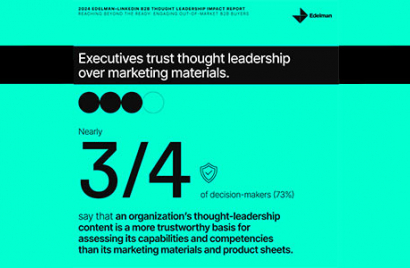
Virgin Media O2 launches summer online safety campaign
Virgin Media O2 and Internet Matters spotlight the importance of having conversations about online safety and starting them early

Edelman’s latest report explores how to stay ahead of trends and create relevant content

Iconic Hollywood actress Lauren Bacall once commented that “standing still is the fastest way of moving backwards in a rapidly changing world.” This is true in business as companies continually seek growth to reinvest and satisfy stakeholders. Yet whilst most CEOs and business leaders place a premium on maintaining momentum commercially, there is a sense that many organisations’ thought leadership tends to ‘stay still,’ simply summarising the current state of play on a topic or following the herd in focusing on the same few industry themes.
The latest Edelman and LinkedIn Thought Leadership Impact study reveals that 54% of C-level executives spend over an hour a week reading thought leadership content and three-quarters see it as the most trustworthy basis for assessing a potential partner's capabilities compared to traditional marketing materials and product information. Nearly two-thirds (60%) would be willing to pay a premium to a company which can demonstrate quality of thinking and the calibre of its people. In a rapidly changing world, there is a hunger for fresh data, new perspectives, and insight amongst business leaders.
Yet only 15% of B2B decision makers feel the quality of the content they see is either good or excellent. The most common pitfalls include thought leadership simply validating existing thinking rather than offering provocative new opinions; an over-reliance on proprietary insights from the company publishing the content and almost half (47%) saying thought leadership doesn’t seem to have been created with a particular audience’s needs in mind.
In a rapidly changing world, there is a hunger for fresh data, new perspectives, and insight amongst business leaders.
Andrew Mildren, Managing Director, Edelman Business Marketing EMEA
Nearly two-thirds (60%) of respondents to our study say that thought leadership is a powerful tool for building credibility when entering a new category, with 57% saying it can help less well-known brands punch above their weight against incumbent players. Brand-led marketing needs time to build recall and mental availability with decision makers, whilst simply pushing product features won’t cut through against established category leaders but people are receptive to smart ideas and provocative thinking even if they are less familiar with the company proposing them.
Thought leadership is the ideal tool for prompting B2B buyers to question the status quo and seek alternate solutions. Three-quarters of decision makers say a piece of thought leadership has led them to research a product or service they were not previously considering. Over half (54%) have been prompted to research an organisation’s capabilities based on it consistently producing high-quality content. Nearly a third (29%) also realised their company was more vulnerable to a potential threat than previously thought.
But if thought leadership is a useful tool for research and discovery, it can also enable current customers to find alternative service providers who can steal your business!
Nearly three-quarters (75%) of business leaders say a piece of thought leadership has occasionally led them to question whether they should continue working with an existing supplier. Quality content has also led 54% to realise there are other suppliers they could work with who have a better understanding of the challenges their organisation is facing. A similar percentage (51%) say thought leadership made them realise there are other suppliers who seem smarter or more visionary.
This leads to action, with a quarter saying a competitor’s thought leadership prompted them to end or significantly reduce their relationship with a current supplier.
Offense is the best defence when it comes to thought leadership. To avoid ‘standing still’ and the risk from rivals, organisations need to take the initiative in three areas.
B2B decision makers provide a clear view on what they want to see in thought leadership. There can be a temptation to rely on a company’s own executives but 62% of respondents are looking for views from prominent, well-respected third-party experts. Over half (55%) expect strong and new data, not just secondary research or reworking of existing data. Rather than solely focusing on longer term, future trends, 43% are seeking concrete advice, tangible examples, and fresh perspectives on the challenges their organisation faces today.
Our study shows that thought leadership has a measurable impact throughout the business buying process. From awareness, perception and ensuring you get invited to bid more often at the top of the funnel; improving understanding, building trust, and deepening customer relationships in the middle of the funnel; and in helping convert business, cross and upsell services and boost margin when deals get made.
A third of respondents (30%) say that their organisation does not really know how to use thought leadership as a sales or marketing tool, with only 29% able to link sales leads back to specific pieces of content. If we recognise the impact quality thought leadership can have through the buying process, this means campaigns can be planned with relevant assets and metrics at each phase. Not only does this prove value but also means one thought leadership programme can work harder within its budget, which can support the business case for investing in this area.
You get out what you put in when it comes to business content. If organisations ‘stand still’ by focusing on tried and tested topics and data, traditional formats, and underinvestment, they will lose business to companies better able to demonstrate the value of their thinking and the talent of their people. Conversely, our study shows that committing to higher quality thought leadership drives new customer acquisition, customer retention, margin and makes it easier to get the next sale.


Andrew is an experienced marketing and communications leader, delivering high impact campaigns which build brands, change perceptions and drive demand. This has included delivering integrated programmes which have boosted engagement and performance, tripled conversion and increased sales and margin. His experience includes audience insights and strategy, creative concepting and campaign development, thought leadership, web, digital and social, content marketing, account-based marketing, partner and sales enablement and earned communications. Andrew has worked across a range of industries including technology, energy, engineering and professional services for some of the world's most recognisable business brands as well as for emerging, fast-growth companies.
Looks like you need to create a Creativebrief account to perform this action.
Create account Sign inLooks like you need to create a Creativebrief account to perform this action.
Create account Sign in